(Click the image to the left for a larger view)
SPECKLED
FEEDER ROACHES - Fact Sheet
Nauphoeta
cinerea
This fact sheet is also available Word for Windows format - Just click this line
Introduction:
The Herp Shop decided to diverge from cricket breeding to Speckled Feeder Roach breeding when the advantages for both ourselves and our customers became increasingly obvious. Following over 6 months of fine-tuning the production and grading methods, numbers are now available to be able to supply these, Australia wide, on a regular basis.
Speckled Feeder Roaches are:
¨ Easy to keep and breed.
¨ Live for up to a year .
¨ Equally as acceptable to reptiles &
amphibians as other foods.
¨ Perfect for Dragons, Geckos, Skinks, Monitors
and frogs.
¨ Unlike crickets, they almost ‘thrive on
neglect’.
What is the Speckled Feeder Roach?
This large roach, growing to almost 30mm in length, has been used as a reptile/amphibian food item for several years in Australia.
An alternative common name is the Lobster Cockroach but as another species carries this same common name, with a different scientific name, it is perhaps wise to avoid confusion and not to refer to N. cinerea as the Lobster Cockroach. Other common names used are the Madeira, Cinereous, Tampa, Speckled and finally "Woodie". As the Australian common name, "Woodie" is inaccurate we have decided to adopt one of the other accepted names "Speckled" and add a slight slant to it. The "Speckled Feeder Roach", which will probably be abbreviated to "Feeder Roach". We will all know what we are talking about.
History:
This species has a worldwide distribution and was originally named Blatta cinerea in 1789 from specimens taken in Mauritius and was not given its present name Nauphoeta cinerea until 1922.
It is a tropical domiciliary cockroach of the New and Old Worlds, occurring in Cuba, Hispaniola, Mexico, Brazil and the Galapagos Islands. In the East, it is widely distributed in the Phillippines, Sumatra and Singapore and occurs in Australia, New Caledonia and the Hawaiian Islands. The East African records extend from Egypt through the Sudan to eastern Tanganyika (now Tanzania), the Transvaal and Natal. It also occurs in Madagascar and Mauritius. Studies indicate that its native home is East Africa. Movement to other countries would have been no doubt by trading vessels and galleons as early as the sixteenth and seventeenth centuries. Colonies were identified in Florida, U.S.A in 1952 and were found established in an area of Tampa, Florida where there were mills producing animal feeds. Hence the common name Tampa Cockroach.
It was firsty recorded in Australia in 1918 where it is regarded as a ‘semi-domestic’ species, as it is found in out-houses and stores rather than in dwellings.
Biology:
This is a false ovoviviparous species in which the oothecae (a cellular egg case) contain 26 – 40 eggs. The nymphs hatch as the female extrudes the ootheca from the brood sac; they shed their embryonic membrane as they hatch and eat both it and the ootheca. Newly hatched nymphs crawl beneath the female, even under her wings, and remain there for about an hour after hatching. In the laboratory the number of nymphs hatching from oothecae increases from an average of 20 from the first egg case to about 30 from the third and decreases thereafter. Female nymphs take longer to mature than males.
Biology of Nauphoeta cinerea based on Laboratory Data (Averages) at 30° C:
|
Minimum period between molt to adult copulation |
6 days in both sexes |
|
Interval between molt to adult and production of first ootheca |
13 days |
|
Interval between moult to adult and hatch of first brood |
44 days |
|
Interval between hatch of successive broods |
1st – 2nd, 40 days |
|
Average broods per female |
6 |
|
Incubation period in brood sac |
36 days |
|
Eggs per ootheca |
33 |
|
Hatched eggs per ootheca |
31 |
|
Percentage of hatched insects that matured |
99% |
|
Number of moults |
7 – 8 |
|
Period of nymphal development |
|
|
in isolation: |
|
|
males (7 moults) |
73 days |
|
females (8 moults) |
94 days |
|
in groups: |
|
|
males |
72 days |
|
females |
85 days |
|
Adult Life Span: |
|
|
Males |
365 days |
|
Females |
344 days |
Keeping & Maintenance:
With basic husbandry practices, ie. Proper holding containers, temperature, hygiene and food – your Feeder Roaches will thrive providing a very balanced food source for your animals at a more economical rate than most other alternatives.
Disadvantages? Perhaps the main one is that they do climb up and out of plastic/glass containers if not prepared properly. This is discussed further in this Care Sheet. A reminder that if these roaches do escape they will not take over your premises.
Housing:
The Feeder Roaches can be kept in plastic containers that are fitted with a lid. For small quantities, round bucket type containers are O.K but for larger quantities large flat sided containers are preferable giving the insects housing with more surface area. These should also come with a lid. The containers I use measure 60cm x 40cm x 20cm deep. The lids should be well ventilated (not just a couple of holes drilled). Cut the majority of the centre part of the lid out leaving just the outer rim and at least a 50mm section all around to fix the mesh to. Purchase enough flywire mesh (the wire one – not the fibreglass one) to cover the cut out section with a bit of overhang. With a hot soldering iron, gently press the flywire into the plastic lid. No glue needed – you now have a perfectly sealed ventilated lid.
| Example Roach Colony Container (Click the image to the left for a larger view) |
As mentioned, the roaches have the ability to climb up and over and out of plastic and glass containers. There are two methods of containing them. The old method is to put a generous smear of vaseline around the top inner surface as was done in the above picture. This generally works but can become a bit messy.
The other alternative is to paint on a product called Fluon ADI. This is painted around the inner upper area of the container and the insects will not be able to climb pass it.
To provide your insects with a hiding area and also increasing the habitable living surface area, obtain some egg box trays, fruit divider trays or opened egg cartons. Place plenty of these down one end of the holding container. If you are using the flat trays be careful to place them so they don’t collapse down on each other once stacked. These can be stacked to a height just under the level of the painted on Fluon.
I put no substrate whatsoever on the floor. This enables it to be cleaned easily.
Your container is now ready for habitation.
Heating:
The roaches do prefer to be kept at 25 - 30° C. This can be maintained by having them on a heat mat or flexible heating element. A probe thermostat or dimmer can control the temperature. The warmer they are, the more active they are.
Feeding:
My colony is fed totally on GR2 (rat & mice pellets) and carrot. Other pellets can be fed, dog & cat, rabbit & guinea pig, Rep-Cal Cricket food etc but the ‘fresh’ carrot is important for moisture. No water is supplied. Provide enough carrot that your colony will devour in two days. Remove any uneaten carrot at this time or earlier if the carrot starts to ‘go off’.
Cleaning:
Shake insects from the cardboard hiding trays, tilt the holding container towards you, scrape any rubbish etc to the front of the box, return hiding material and roaches will go back under this. After a few minutes all that is left at the front end of the box is the rubbish which can then be removed. Practice makes perfect.
Handling:
The roaches can be quite fast but cooling can control their speed. Naturally, when they are on a heat mat and kept at 30° C they are at their full potential, speed wise. Even by removing the container from the heat source and placing on the floor, particularly in the cooler months, is enough to slow them down to half speed. With a bit of practice and experimentation, you will find the method that suits you best.
Removal from the holding container can be achieved in several ways and you may come up with some better methods. These are a few suggestions.
If you require them to be slowed down, catch them first and place in a container that can be put in a cool place, even in the fridge. How slow you want them to be can be worked out on the time you leave them in the fridge or the cool spot. Another way of slowing them down, whilst still offering ‘live’ food to your animals is by decapitation. Simply, with a pair of scissors, cut off the heads before you offer them to your animals. They will still have movement for a short amount of time and this also eliminates the possibility of escapees or hiding from the predators. Many of your animals will adjust to eating whilst being held by tweezers or forceps. Remember to dust your insects with Rep-Cal Calcium & Herptivite Multivitamins.
How good are the Speckled Feeder Roaches?
An email from clients:
Bob - 15th May 2001
G’day Brian,
Bob from Cooranbong. I would like some more of your lovely roaches. Believe it or not I’m out. The cunninghams, gilberts, painteds, beardies, jackies, crevice, netteds, spencers, scalaris etc reckon they’re fantastic. Could I please have 2 x 30 day old and 3 x 55 day old. I can see the tongues flickering already.
Larrissa - 21st May 2001
"I think we'll be using you a lot. Our dragons were quite impressed with the roaches and they are much easier for me to catch!"
Bruce - 31st May 2001
Please send 26 .40 or 120 grams of 20 mm speckled feeders, your right the monitors especially the tristis do seem to like them more than crickets and the buggers don't jump regards Bruce
Lynette - 12th June 2001
The roaches are doing well...much easier to look after than crickets I can see your preference to them! They are also lasting much longer...they were a bit creepy at first in their quick movements but all is well now.......
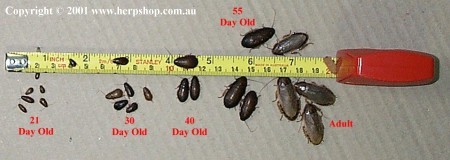
|
Approximate Size
|
average weight per 100
|
Price
|
|
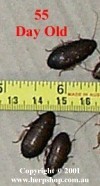 |
25 mm
|
50 grams
|
$6.60 per 50 grams
|
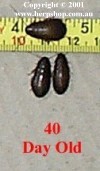 |
20 mm
|
20 grams
|
$4.40 per 20 grams
|
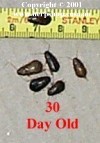 |
15 mm
|
8 grams
|
$5.50 per 10 grams
|
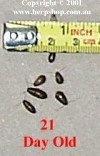 |
10 mm
|
5 grams
|
$3.30 per 5 grams
|
| Delivery: Sent anywhere in Australia by Australia Post (Express Post). Mailing out day is Sunday each week, orders to be in by Saturday lunchtime. Prices do not include postage. Express Post/Pack up to 500gm is $7.95. | |||
|
|